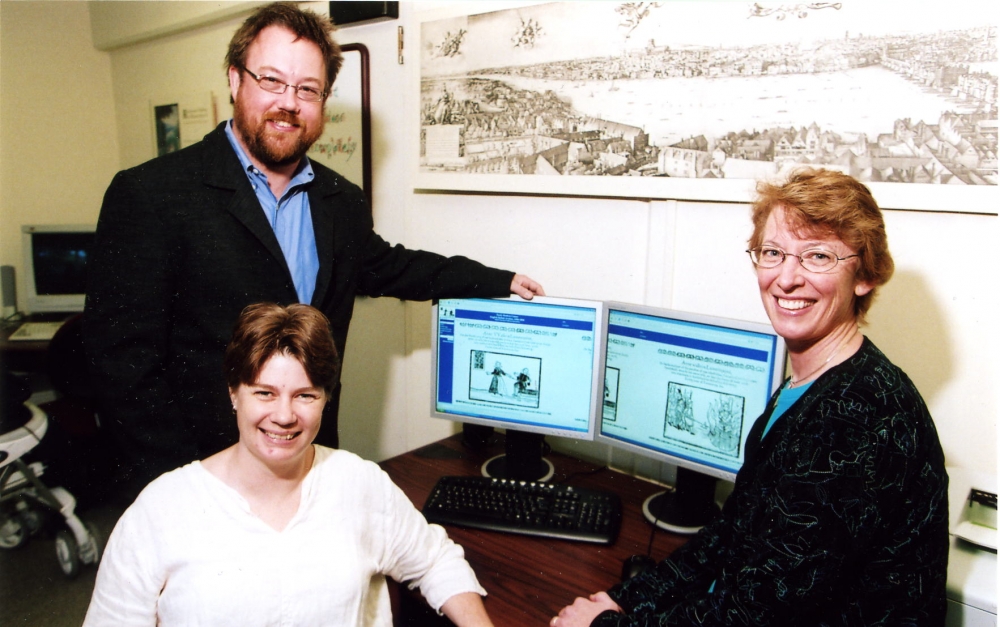
In a marriage of literary history and 21st-century technology, the Early Modern Center at the University of California, Santa Barbara, has established the English Ballad Archive, a collection of English broadside ballads posted on the Internet in their original format. The ballads, which number in the thousands and date back to the 16th century, are rhymed accounts of sensational news events and satisfied the public's hunger for news and gossip in much the same way that tabloid magazines and newspapers do today.
With a $325,000 grant from the National Endowment for the Humanities, the Early Modern Center, a research unit within the Department of English, has, as its first project, cataloged and posted detailed facsimile transcriptions of more than 1,800 ballads in the Samuel Pepys collection (http://emc.english.ucsb.edu/ballad_project). The collection dates to the 17th century and resides permanently in the Pepys Library at Magdelene College in Cambridge, England. Eventually, the English Ballad Archive will include all extant ballads from about 1500 to1800.
Often composed by anonymous writers, the ballads were set to popular folk tunes and were sung on street corners and other public places. Copies of the lyrics-commonly known as broadsides because they were printed on one side of a single broad sheet of paper-were distributed by the singers and posted for viewing just about anywhere, including bookstalls, alehouses, and private residences. In addition to the texts and the titles of the music to which the lyrics should be sung, these broadsides also featured detailed woodcut illustrations. They were simultaneously poems, songs, and art.
"Ballads were a common and very popular form of communication beginning in the 16th century," explains Patricia Fumerton, professor of English and director of the English Ballad Archive project.
Until recently, accessing original broadside ballads has been a challenge for scholars. Because of their fragility-they were printed on cheap, degradable paper-collections have become carefully guarded treasures. In addition, the ballads themselves are extremely difficult to read due to the crude printing process used to create them, and their thick black-letter-or gothic-type style.
Fumerton, however, was granted unprecedented rights to digitize the Pepys collection's ballads from microfilm and post the images online. Working closely with the project's manager, Tassie Gniady, a UCSB graduate student, she has mobilized a team of graduate and undergraduate students to transcribe the black-letter font into easily readable white-letter-or roman-type, and then to insert the transcribed text within the ornamental frame of the original image. Visitors to the project's Web site can thus see facsimiles of the original ballads and also facsimile transcriptions, which preserve the ornamental look of the original broadside while showing the text itself in modern print. In addition, the site provides audio recordings of the ballads, background essays that place them in a cultural context, additional essays regarding Pepys's categories for his collection, and a search function that allows readers to find specific ballads quickly and easily.
At present, the Early Modern Center has posted and extensively cataloged facsimiles of the entire Pepys collection, making it fully available online. As the ballads are further transcribed and audio recordings are made, the modern texts and sung versions will be added to the database.
Of course, the ballads can't come fully alive without the accompanying music, and while some of the tunes are well known, others have been difficult to identify and reproduce. The principal sleuth for this part of the project is Revell Carr, a specialist in ethnomusicology who received his doctorate degree from UCSB in 2006. Carr has relied primarily on Claude M. Simpson's reference book "The British Broadside Ballad and its Music" (Rutgers University Press, 1966) to identify otherwise unrecognizable tunes. Simpson's work provides transcriptions of unadorned melodies painstakingly researched and reconstructed, combined with detailed references to the historical sources of the tunes.
"The ballads are sung a cappella as they would have been on the street," Fumerton said. "We have about 100 recordings now, and our goal in the next year is to have 1,000 more."
The electronic archive conforms to the guidelines set by the Text Encoding Initiative (TEI) and XML, a standard computer language. TEI is the most widely used international standard for electronic encoding of literary texts, with standards endorsed by the National Endowment for the Humanities, the Modern Language Association, and the United Kingdom's Arts and Humanities Research Board. The TEI is being implemented in XML under the guidance of the project's technical specialist, Carl Stahmer, another Ph.D. graduate from UCSB.
Related Links



